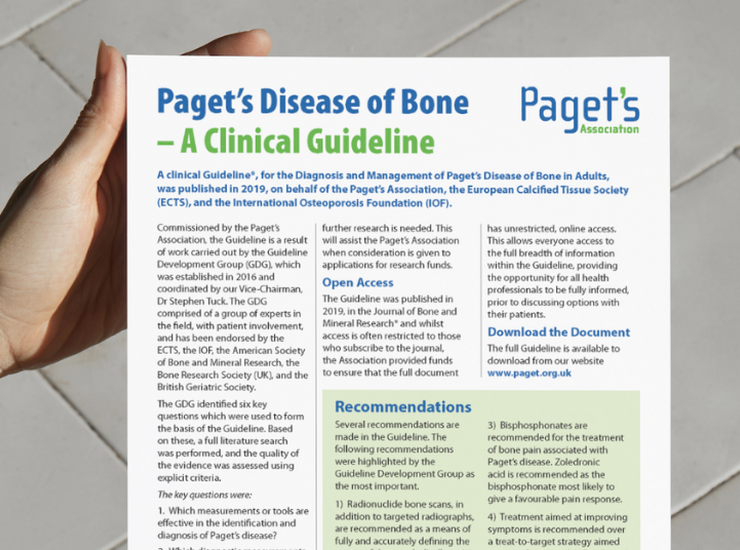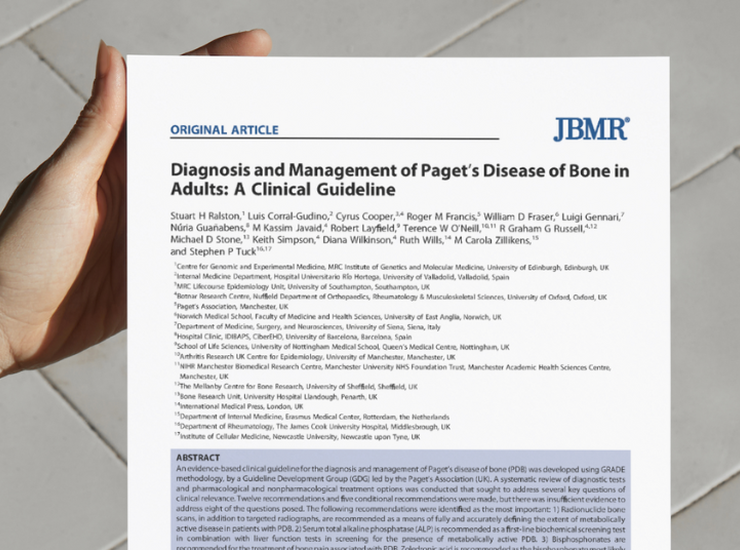Paget’s Disease of Bone
Assessment and diagnosis
When Paget’s Disease of Bone (PDB) is suspected, there must be a detailed assessment process, including any family history of the condition.
Clinical features
Many clinical features and complications of PDB are thought to be due to the abnormalities of bone remodelling. In many cases, individuals are unaware that they have the condition and may never develop symptoms.
- In those that present clinically, bone pain is the most common symptom.
- The blood flow to active areas of Paget’s disease increases due to the high rate of bone remodelling. This can sometimes lead to a feeling of warmth over the affected bone.
- The affected bone may become enlarged and misshapen.
Diagnosis
- The most widely used biochemical marker to aid diagnosis of PDB is serum total alkaline phosphatase (ALP), which is typically elevated in active PDB.
- The condition has characteristic features on x-ray. Individually, these features are not specific, but when they occur in combination, they are usually diagnostic.
X-ray features of PDB
- Osteolytic areas
- Cortical thickening
- Loss of distinction between cortex and medulla
- Trabecular thickening
- Osteosclerosis
- Bone expansion
- Bone deformity - Radionuclide bone scintigraphy is widely considered to be a valuable technique for the diagnosis of PDB and to assess the extent of the disease.
Centres of Excellence
Most UK hospitals have a specialist who can deal with the condition. If there is no specialist locally, then referral to one of the Paget’s Association (NHS) Centres of Excellence might be beneficial.
Management
It is recognised that not everyone with Paget’s disease requires treatment, because, in many cases, it causes no symptoms nor complications. Decisions to treat Paget’s disease should be made by a specialist, on an individual basis. Specific anti-pagetic treatment involves the use of osteoclast inhibitors to reduce the elevation in bone turnover that is characteristic of active disease. In addition, analgesics, non-steroidal anti-inflammatory drugs, and anti-neuropathic pain agents can be used for symptom control.
Zoledronic Acid
For those who require treatment, the current first-line bisphosphonate, due to its potency and prolonged duration of action, is zoledronic acid. It is the bisphosphonate most likely to relieve pain from active Paget’s disease. A single infusion of 5mg can be effective for many years.
Risedronate
Risedronate is also an effective treatment and is given orally once a day, 30mg for 2 months. Risedronate also helps relieve pain from active Paget’s disease with effects that can last for 2 years or more. The duration of effect is not as long as that of zoledronic acid.
Pamidronate
Pamidronate is an effective treatment but has largely been superseded by zoledronic acid. Pamidronate is given in several doses, intravenously and repeated when necessary, depending on symptoms. Doses can vary, but commonly 60mg is given by an infusion and this is repeated on 3 consecutive days.
Calcitonin
In cases where bisphosphonates are not recommended, calcitonin injections may be considered to treat bone pain in Paget’s disease.
Follow up
An assessment of the response to treatment should take place between 3 and 6 months after treatment has been completed.
Complications
The overall frequency with which complications occur in PDB is unknown but when they occur, surgical treatment is often required. Medical treatment with bisphosphonates is seldom effective at treating complications of Paget’s disease when they are established.
Bone Deformity: Paget’s disease can cause bone to become enlarged and misshapen. Long-standing disease may cause the weight-bearing bones of the leg to bow.
Osteoarthritis: Paget’s disease can predispose to the development of osteoarthritis at adjacent joints. Joint replacement is common in those with Paget’s disease. The changes of Paget’s disease usually affect only one side of a joint and are not present in both bones that make up the joint.
Fracture: There is an increased risk of fracture (Figure 1), particularly in the weight-bearing bones of the legs. Fractures may initially be incomplete, (stress fractures or fissure fractures), which are at high risk of complete fracture. Fissure fractures predominantly, but not exclusively, affect weight-bearing bones, such as the thigh bone (femur). Hearing Loss If the skull is involved, hearing loss can occur.
Nerve Entrapment: Enlarged bones may cause nerve compression. Complications can therefore include basilar invagination of the skull, obstructive hydrocephalus, spinal canal stenosis, and paraplegia. It has been suggested that, in some cases, paraplegia may be due to a vascular “steal” phenomenon, rather than direct compression of the spinal cord.
Excessive Blood Loss During Surgery: Owing to the increased blood flow to areas of active PDB, were the bone to fracture or surgery be undertaken, active disease would have the potential to result in excessive blood loss in patients undergoing surgery.
Cardiac Failure: In severe cases, high-output cardiac failure, due to increased bone blood flow, has been reported but is extremely rare, especially as Paget’s disease is decreasing in severity.
Paget’s Associated Osteosarcoma: Osteosarcoma associated with Paget’s disease is a rare primary bone cancer. It should be suspected in any patient with Paget’s disease, where there is a sudden increase in bone pain. Patients suspected to have osteosarcoma should undergo urgent imaging with a CT scan or MRI and be referred for a surgical opinion.
Clinical guideline
Several recommendations are made in the 2019 clinical Guideline. The following were highlighted by the Guideline Development Group as the most important. You can download the guideline below.
- Radionuclide bone scans, in addition to targeted radiographs, are recommended as a means of defining, fully and accurately, the extent of the metabolically active disease in patients with Paget’s Disease of Bone.
- Serum total alkaline phosphatase (ALP) is recommended as a first-line biochemical screeningtest, in combination with liver function tests, in screening for the presence of metabolically active Paget’s Disease of Bone.
- Bisphosphonates are recommended for the treatment of bone pain associated with Paget’s disease. Zoledronic acid is recommended as the bisphosphonate most likely to give a favourable pain response.
- Treatment aimed at improving symptoms is recommended over a treat-to-target strategy, aimed at normalising total ALP in Paget’s disease.
- Total hip or knee replacements are recommended for patients with Paget’s Disease of Bone who develop osteoarthritis, for whom medical treatment is inadequate. There is insufficient information to recommend one type of surgical approach over another.

Paget's Disease - Information for Professionals
Case studies, diagnosis, management and more can be found in this booklet for all healthcare professionals caring for those affected by the condition
PDF 1.3mb

Clinical Guideline - Summary
A clinical Guideline, for the Diagnosis and Management of Paget’s Disease of Bone in Adults, which assists health professionals to consider the evidence and discuss options with t…
PDF 1.2mb

Clinical Guideline - Full
The full clinical guideline for the Diagnosis and management of Paget's Disease of Bone in Adults
PDF 2.8mb
